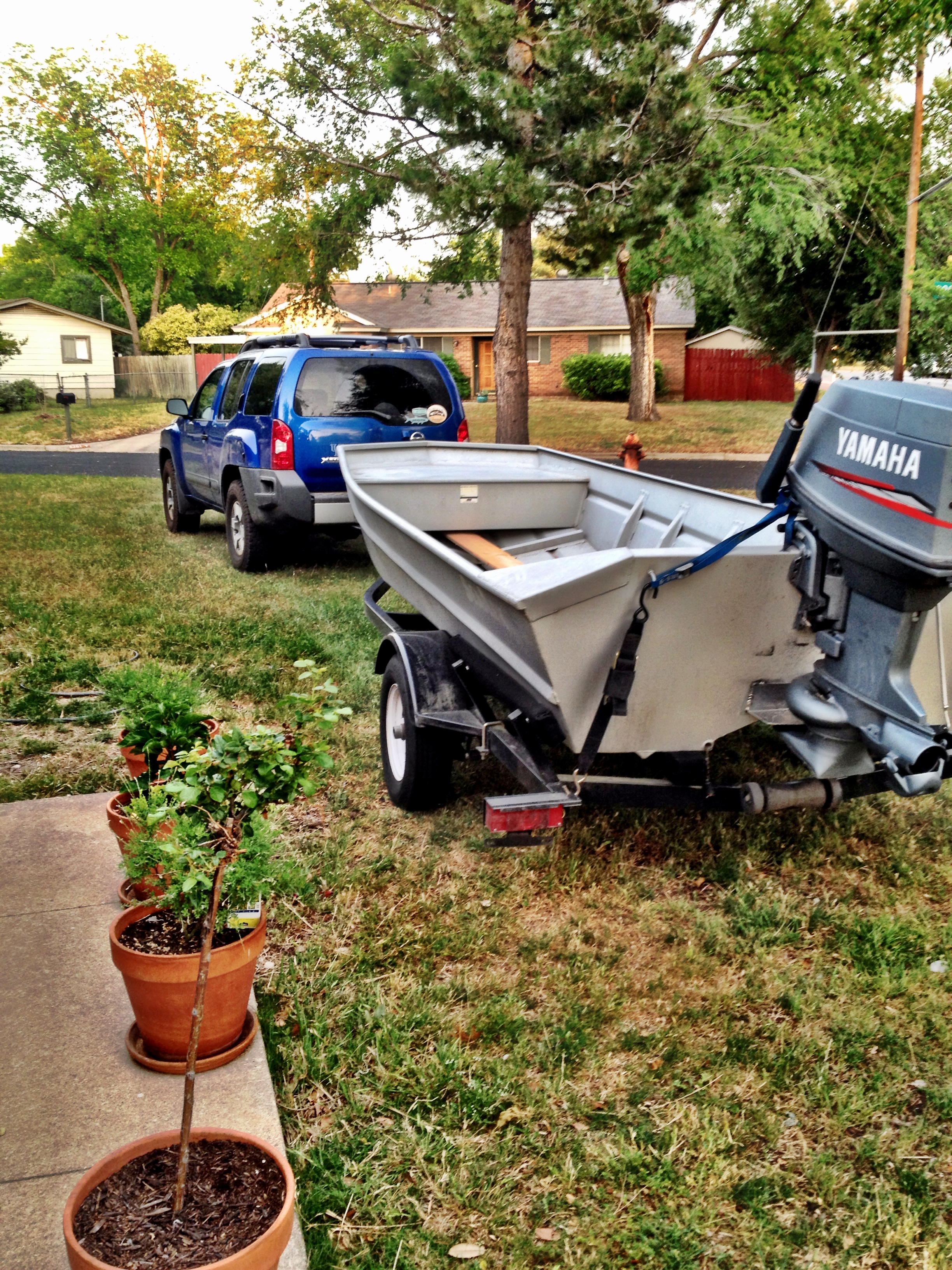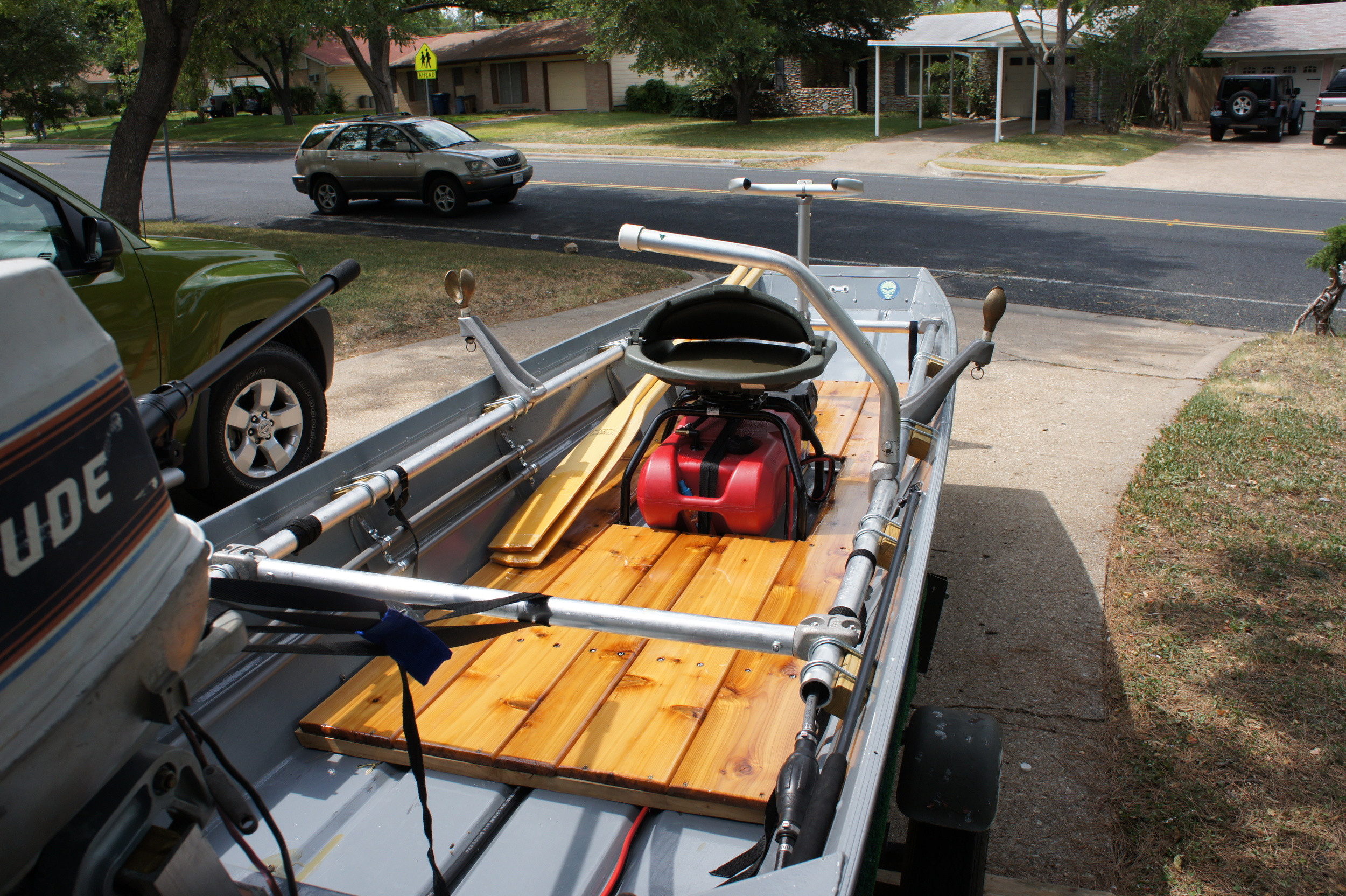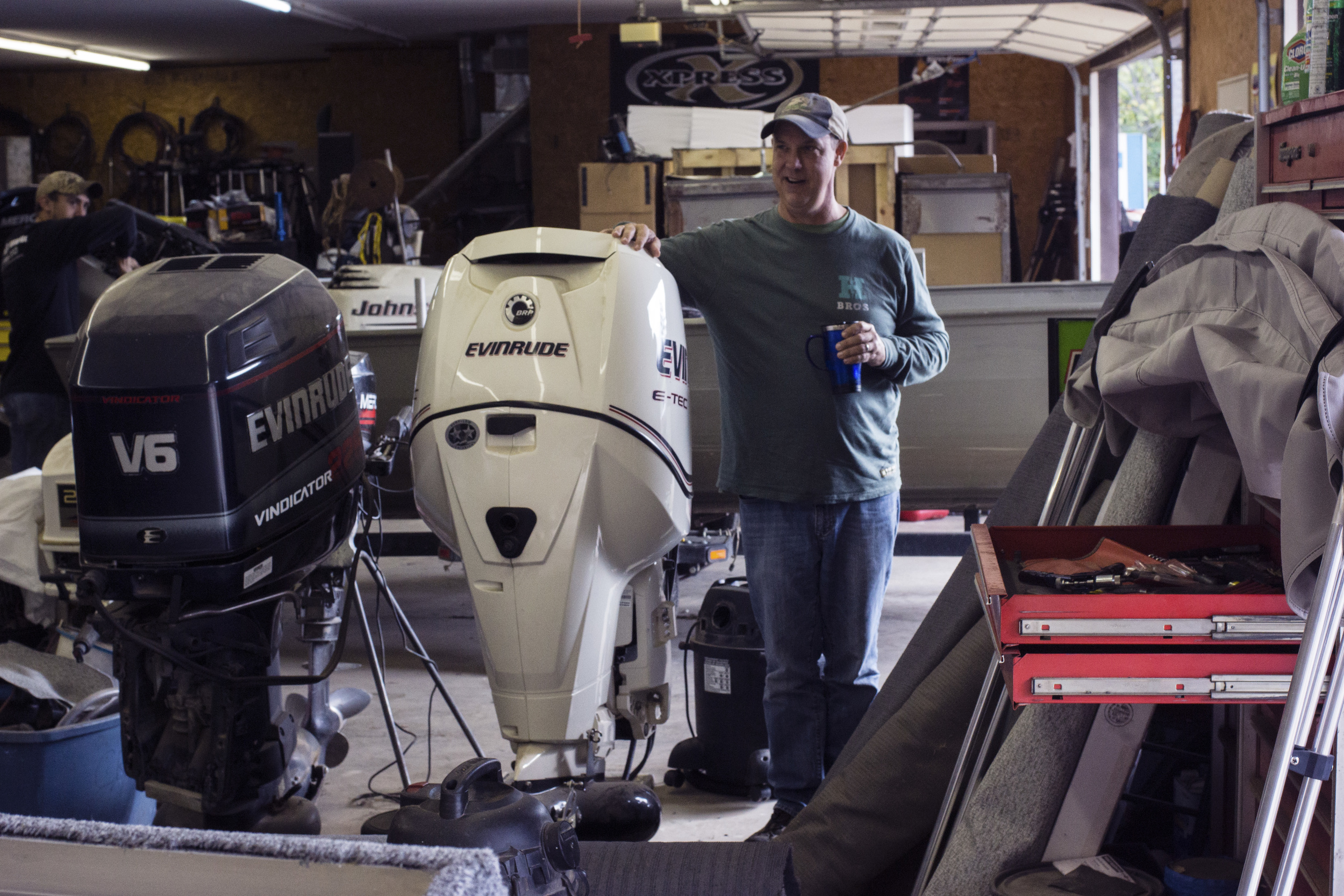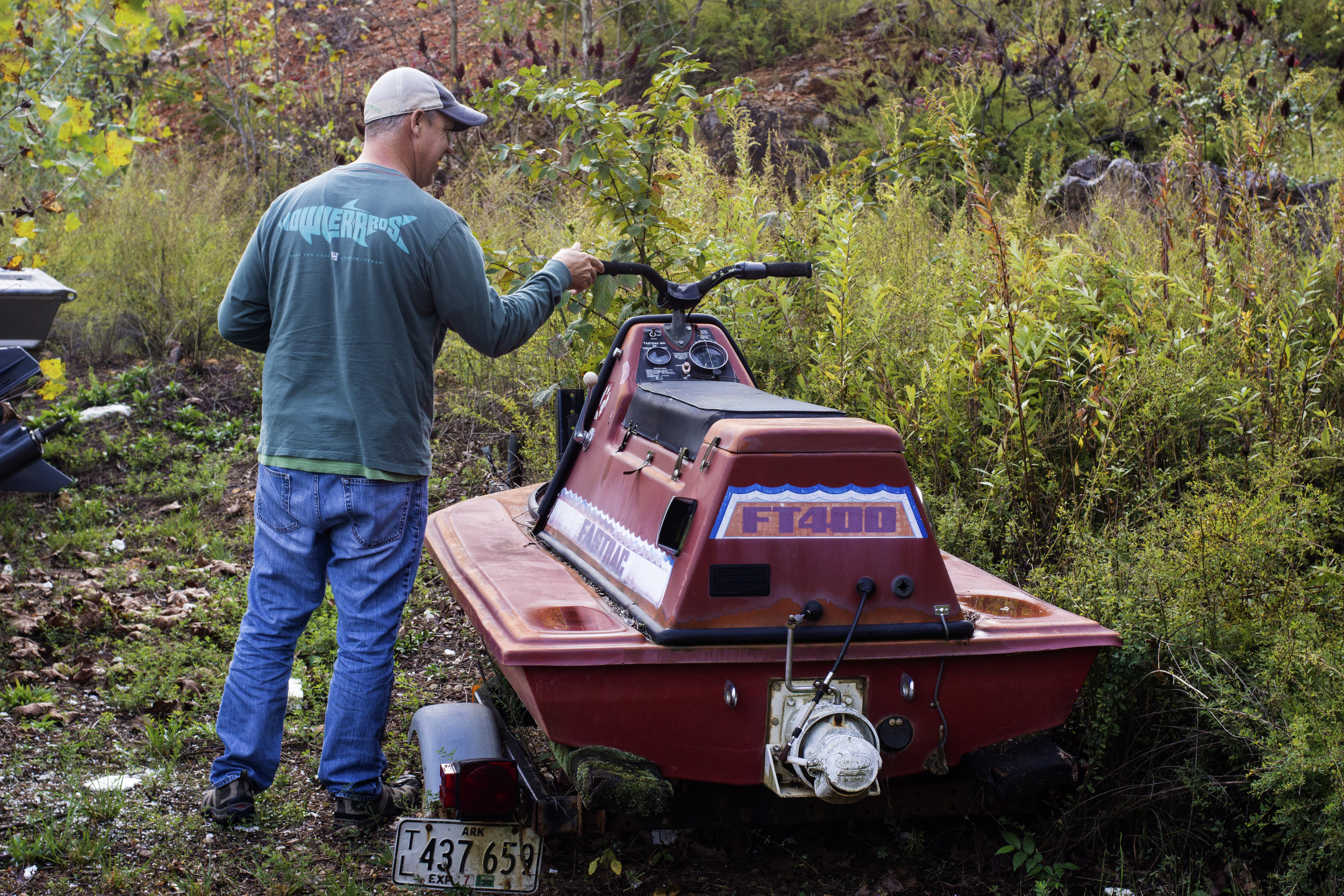Jet Sled version 2 second edition
how to park a let sled on the river
So here it is. I’m actually glad my laziness got the better of me as I’ll be able to do this in one sitting versus boring you all to tears with each individual step. I assumed this would take much longer than it did.
First picture of my new boat. About 30 seconds later my wife was informed of our new purchase.
After a bunch of research I decided on a SeaArk 1652 MVT (tunneled hull version). 16’ seemed about the right amount of boat, length wise and the wider the better. The decision to go with SeaArk was made after talking to several smaller boat builders in the Midwest, as they all seemed to, at some point in the conversation compare their boats to SeaArks in build, materials, etc. Alvin and JD had already made a couple trips to Currant River Marine (CRM) and under their advice I called Freddy to see what he had available. Long story short I was soon on my way to Currant River Marine in Doniphan, MO with my engine in the back of the Xterra. After a 16 hour drive they hung the engine, we ran the Currant River for a few minutes, and I signed some paperwork. By 5pm I was checked in to a cheap hotel ready to get a zero dark thirty start for the 16 hours back to Austin.





Freddy and the gang were worth every minute of the drive and their knowledge of lower-unit-less engines and boats is beyond awesome. I look forward to my return for a new engine.
Like I said in the previous post, I was going to do the exact same thing to this boat that I had done to the blue one. The SeaArk had a slight V in the Hull and I decided that needed to be addressed first. I had 4”x 4” 90 degree angle aluminium welded into the ribs to create a flat surface to build the flooring on. The flooring was Cedar planks that I sanded, epoxied, sanded, epoxied, sanded, epoxied and then sanded one more time with a final coat of spar varnish for the UV protection. I love wooden boats. My grandfather used to build them. I couldn’t not have the wood floors again, however, they are a huge pain in the ass to fit. I’m a huge fan of brute force and ignorance and in my diving days solved many problems with the idea that if a hammer wasn’t working a bigger one would. Fortunately, I was able to use the same tools my grandfather had used in his boat building; unfortunately his knowledge and experience did not magically pass through the tools as I had hoped it would. He died many years ago and I thought of him a lot while using them mostly during my many moments of frustration in not being able to beat the wood into submission with a larger hammer. The floors look great, however I can see every moment of frustration when my patience (or lack thereof) got the better of me. Guests don’t seem to mind.






Supervision a year later...
Once the side pieces were cut and fitted to the ribs of the boat the rest went pretty quickly. I also can’t help but to think of my daughter, Poppy, who supervised the last boat, she was only a few months old and was pretty easy to occupy. She’s now almost 2 and has ZERO ability to sit and keep my company.
So that’s the floors. I was, at first, going to do lean bars and knee braces however after the first couple trips I’ve found out they aren’t really needed. It’s my opinion that maybe they create a false since of security for the anglers and without them my clients seem to have a better awareness of themselves and their movements while in the boat as long as I communicate my intentions while on the oars which is better for a lot of reasons. Speaking of the oars, I also didn’t have to create the “frame” like I had before. Oar locks u-bolt directly to the gunwales, which I need to move about a foot forward (boat forward) to give the front guy a little more room.
I, of course, have a laundry list of things to do still with rod holders being the first and some sea deck type stuff for the front casting platform (it gets hot) but since the boat was new there was no need to paint and do all that other nonsense that kept me so busy on the last project. Having the blue boat in my past made doing this boat so much easier, mainly because it was new…
Please contact me with any questions that I most likely did not answer. Alvin, JD and I would be more than happy to share what we’ve learned. We all run different rigs each having their own pros and cons.
Enjoy,
AWG
Jet Sled version 2
Clay loading up a rod after a successful first run
A little while ago I bought a project and I'm about to start the process again. Last time I had a lot of requests to write a build report and not having the platform to do so I used FB which was me just posting a lot of pictures with out much reporting or content. This time around I plan to use this site and as this begins to take shape write about it.
So…the last project was a Jon or John boat with an outboard jet drive. From now on I’m just going to refer to these boats as Jet-Sleds. My first Jet-Sled (V1) was a riveted Alumacraft 1432 (14 feet long and 32” on the bottom) with an old Evinrude 25 hp.
Somewhere on I-35 Fueling up on a Double Quarter pounder
I really was Just buying the engine for another boat so I really didn’t care if the boat leaked (it did) or what condition it was in (rough). If I could get it for the right price (I did) the engine wouldn't even need to run (it didn’t). I had done enough research and talked to mechanics, friends and who ever would listen. We were confidant that if it didn't run 800 bucks would fix that (it did). The boat was reborn, used for a while with friends then sold when I ruptured my Achilles tendon, which was fine, I wasn’t in love with the boat. She was a handful on the water and in no way conducive to guiding. She did however run like a scalded dog and had a unique look. I plan to fix the “handful” problem with waterline and will most likely shoot for the same look and outfit the V2 Jet-sled in the same manner.
I really enjoyed the last project and tolerated (very well I must say) all the “dude, when ya gonna be done so "WE" can go fish in it” or “dude, your OCD”. This project will most likely take longer. Jet-sled V1 came as a package deal…Boat, Motor and trailer, at present time I have none of what I need accept a clearer understanding of what worked and what didn’t, that and a line on a 40/30 Yamadog.
Poppy supervising while I work, She's 18 months now so this wont work.
Stay tuned sports fans I’m looking forward to this project and sharing it on this web sites blog
Enjoy, tight lines and shallow running boats.
Winston
Jet Boatin' Road Trip
Jeff Davis and I took a little road trip to southern Missouri the other day. The reason was to pick up a jet drive outboard for my new Hog Island Skiff. We kept getting asked why we were driving so far to buy a boat motor.
Well you see this is no ordinary boat motor. Outboard jets are not real common in this part of the country. Anglers in Arkansas and Missouri have used jet powered boats for years to access shallow rocky sections of their rivers that conventional prop driven boats would never survive in.
On rivers where there is little access or long distances between put ins and takeouts, a jet boat can open up miles of seldom fished water. When floating under oar or paddle power fishing a 6 mile section of the river can take all day. With the option to use the engine we can cover 12 to 20 miles of water with no problem. Because we are in no hurry to get downstream we can take our time in the best water and motor through the less productive sections.










